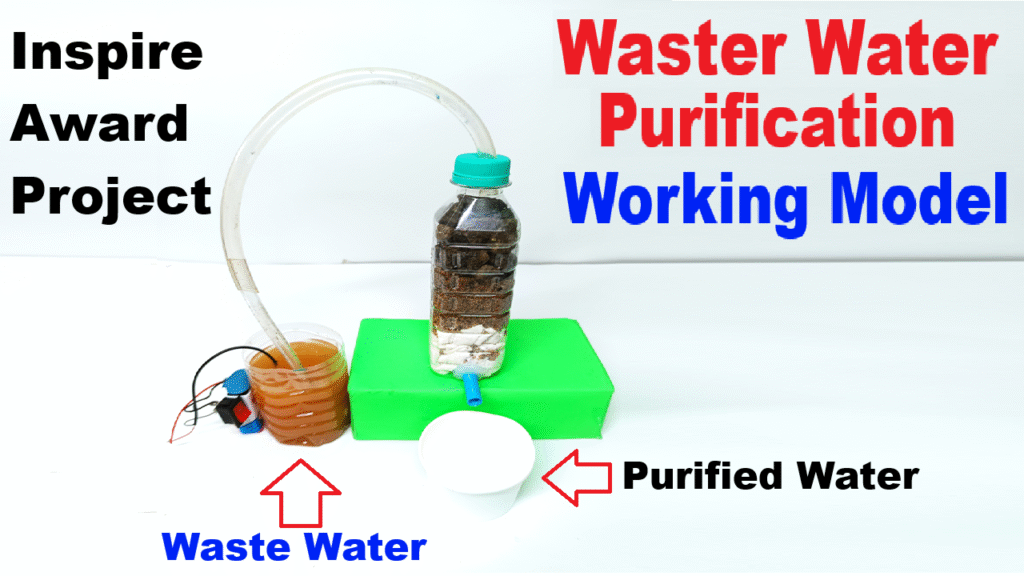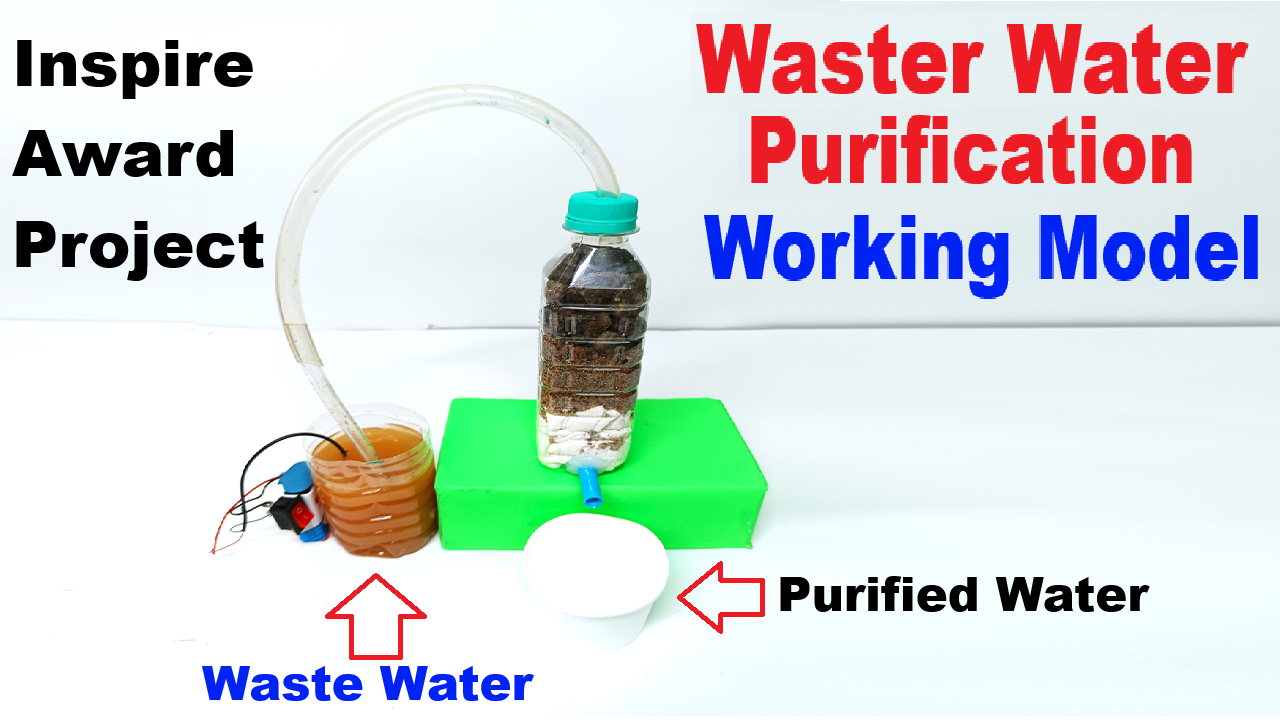Introduction
Water is one of the most vital resources on Earth, but water pollution is a major global challenge. Untreated wastewater contains dirt, sediments, chemicals, and harmful microorganisms that are unsafe for consumption or irrigation. To address this, wastewater purification systems are used to remove impurities and make water usable.

This project demonstrates a DIY Waste Water Purification Working Model using a plastic bottle, four layers of filtering materials, and a DC water pump. It is designed to visually show the step-by-step filtration process, making it ideal for Inspire Award science exhibitions.
Objective
- To demonstrate how wastewater can be filtered and purified using simple materials.
- To provide a hands-on understanding of water filtration principles.
- To showcase an interactive, low-cost, and innovative model for students and exhibition visitors.
Materials Required
- Plastic bottle (1–2 liter) – main container.
- Four types of filtering materials:
- Large gravel/pebbles – to remove large debris.
- Small gravel – to remove finer particles.
- Activated charcoal/coal – to absorb chemicals and odors.
- Sand – to filter fine particles and sediments.
- DC water pump (small, submersible) – to pump wastewater to the top.
- Tubing/pipes – to connect the pump and bottle.
- Plastic funnel – optional for pouring water.
- Plastic container – to collect purified water at the bottom.
- Dirty water – for demonstration purposes.
Video Construction Steps
1. Preparing the Bottle
- Take a clean plastic bottle and cut off the top if needed to easily fill water and filter materials.
- Drill or puncture a small hole at the bottom for purified water to flow out into a container.
- Secure the bottle upright on a base for stability.
2. Layering the Filters
- First Layer: Large Gravel
- Fill the bottom of the bottle with large gravel.
- Purpose: Remove large debris like leaves, stones, and plastics.
- Second Layer: Small Gravel
- Add a layer of small gravel above the large stones.
- Purpose: Trap smaller particles and sediments.
- Third Layer: Activated Charcoal/Coal
- Add a layer of activated charcoal.
- Purpose: Absorb chemicals, bad odor, and impurities from wastewater.
- Fourth Layer: Sand
- Add a top layer of sand.
- Purpose: Trap fine sediments and particles for clear water output.
3. Water Pump Setup
- Connect a small DC water pump to a 9V battery or power source.
- Use tubing to guide water from a dirty water container to the top of the bottle.
- When the pump is switched on, water flows through all four layers sequentially.
4. Collection of Purified Water
- Place a plastic container at the bottom of the bottle to collect filtered water.
- As water passes through each layer, impurities are removed step by step.
- The output at the bottom is clear and visibly purified.
Working Principle
- Mechanical Filtration (Gravel & Sand)
- Large gravel removes debris.
- Small gravel and sand filter finer particles.
- Chemical Filtration (Activated Charcoal)
- Charcoal absorbs dissolved chemicals, odors, and some bacteria.
- Flow Mechanism (DC Pump)
- The pump ensures continuous water flow from the top.
- Gravity and filtration layers purify water as it moves downward.
This layered filtration mimics real-life water treatment processes like sedimentation, filtration, and chemical absorption.
Advantages
- Low-cost and easy to build.
- Demonstrates real-life wastewater purification in a small model.
- Interactive and visually appealing for exhibitions.
- Helps students understand environmental science, water conservation, and engineering principles.
Demonstration in Exhibition
- Pour dirty water into the top of the bottle.
- Turn on the DC water pump to start the flow.
- Explain each layer’s function as water passes through.
- Collect the purified water at the bottom to show visible results.
- Highlight the importance of wastewater treatment for health and environment.
Conclusion
This Waste Water Purification Working Model effectively demonstrates how polluted water can be made clean using simple materials and scientific principles. Using a plastic bottle, four filtration layers, and a DC water pump, the model shows stepwise purification in an easy-to-understand way. It is perfect for Inspire Award projects as it combines innovation, sustainability, and educational value, providing a hands-on learning experience for students and exhibition visitors.

